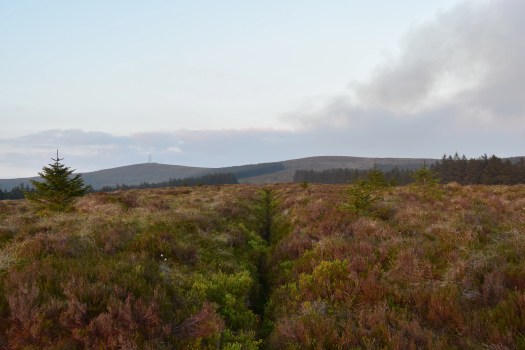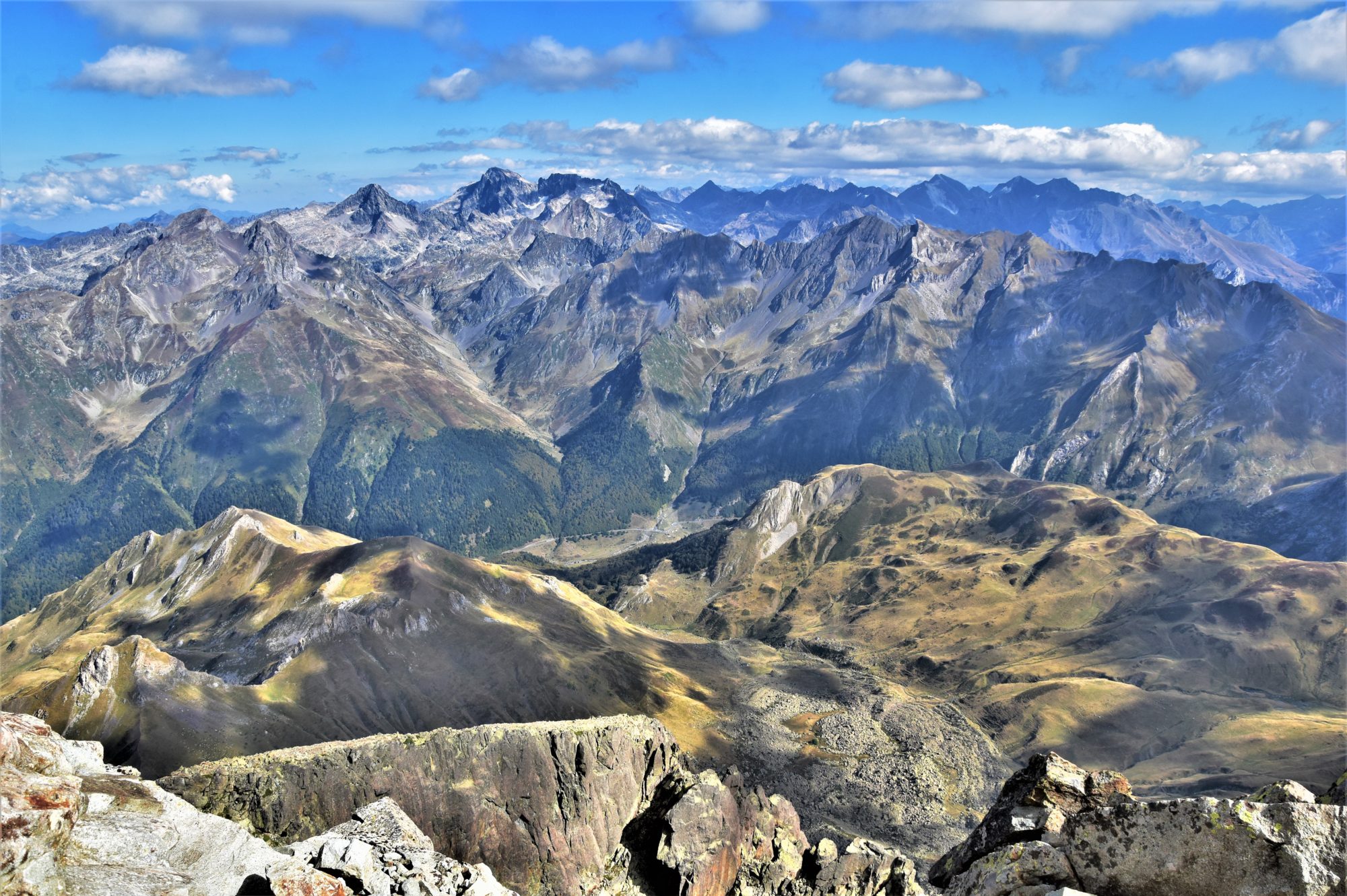
Fourteen years. Fourteen years I had not been back to Scotland. I had only been there once actually, in April 2003. An eight-day road-trip, with only two walks. Since almost a year, I keep dreaming about these wild, wide open spaces of moorlands and countless lakes and mountains, and especially these scary munros which rise so steeply above the Highlands. And now I can hear you ask: what is a munro ?

The British are experts at creating various lists of summits. These lists take into account the height, but also the prominence of a summit, i.e. the difference of height between the said summit and the highest point which separates it from its geographically closer, higher neighbour… Was I clear enough (I must say this is a bit complex…) ? Anyway, apart from height and prominence, some lists have been elaborated by passionate hikers, true pioneers of modern hill-walking, with more subjective criteria. For example, Alfred Wainwright (1907-1991) has drawn up a list of 214 summits of the Lake District (England) in the 1950-60s, rather according to their presence as a landscape feature than to their actual height or prominence: these are the wainwrights.

Before him, Sir Hugh Munro (1856-1919) had established a list, which he presented in 1891, of 282 distinct Scottish summits of over 3000ft (914.4m), according to his own criteria of height and prominence (i.e. with no proper measurement): these are the munros.

Hill-bagging -or peak-bagging, i.e. “collecting” summits- is a national sport in Great Britain, but also in Ireland, the country where my peak-bagging adventures really started. After a few short hikes in 1996/97 during my first stay in Ireland as a student, I bagged my first summits in Connemara in september 2005. The next year, I climbed Carrauntoohill, Ireland’s high point at 1038m. But only by the end of summer 2012 did I open my old OSI maps again in order to spot the +500m summits. And then I found the amazing http://mountainviews.ie/ website, which presents different lists of summits, including one of the +500m (a total of 570, of which I have bagged 245 so far). As a logical continuation, it sounded all the more natural to then get interested in Britain and its wainwrights, munros, etc…

The reason of my return to Scotland was the opportunity to try and achieve some munro-bagging. As of 2017, over 6000 hikers have declared having climbed the 282 summits to the Munro Society, which is in charge of updating the list of “compleaters” of a “munro round”, also called “munroists”. No need to say this is a serious matter in Scotland !! And so it is in reality. Indeed, despite their relative modest height by European standards (Ben Nevis, the highest peak of the British Isles reaches a mere 1345m), the munros have all the characteristics of some higher mountains. The starting points are usually at low altitude, often close to sea level, and some of the summits are extremely isolated, requiring a two-day trip. Moreover, the high ground is often pathless, which requires acute navigation skills to find your way across immense patches of sometimes very boggy moorland -home to the terrible midges, those tiny insects which literally eat you alive (alright, I do exaggerate, but just a bit)- and over impressive rocky ridges where the use of hands is regularly required.

Some summits on the Isle of Skye -like the amazing Inaccessible Pinnacle or Sgurr nan Gillean and Am Basteir (see pic below)- even remain out of reach of the common hill-walker.

And then there is the often unreliable, ever-changing weather. The rain which makes the rock slippery, turns the moorland into marshy bogland and turns gentle streams into raging rivers in spate; the snow, which can fall any time of the year and often covers the main tops late in the season; the mist or low clouds, which make orienteering particularly difficult; and last but not least, the wind, arguably the worst enemy, which wears you out and can sometimes blow strong enough to make you trip over and fall off the slopes.

Climbing a munro -and all the more several- is a real endurance test and requires a certain preparation. You need proper gear of course, need to check the weather forecast, try and find some information about the main difficulties which are to be encountered on the way -the website https://www.walkhighlands.co.uk/ has loads of useful information- plan the route accurately, including some escape routes which would allow to shorten the walk and reach a safe place in case the weather turns really bad. Of course, apart from some very frequented routes with well-defined paths (Ben Nevis, Ben Lomond,…), it is strongly recommended not to venture on your own unless you have already a bit of experience on these kinds of terrain. And should you decide to go on your own, best is to tell someone where you intend to go.

Until now, the only munro I had climbed was thus Ben Nevis (1345m). A tough haul up as it starts only around 30m above sea level, nevertheless the well-maintained path makes for an easy ascent. Not enough to proclaim myself as being experienced. I actually mostly built my personal experience on such similar ground made of peat, water and rock during my numerous, recent trips to Ireland. The bit of experience of the higher mountains I have gained while climbing a few of the highest peaks in the Pyrenees.


Apart from the McGillicuddy’s Reeks, where Carrauntoohill stands, Ireland does not have many areas which could claim to have a profile of high mountains. But in my opinion, Ireland is an excellent school to learn how to get oriented, as you often have to venture off-track to reach some of the higher summits. This is both physically and mentally demanding, as the various types of uneven terrain and the ever-changing weather force you to adapt and to be watchful constantly. And even though there may not be much climbing to be done at one go, this is far from being a gentle hike up a marked trail !!




While England and Wales, a bit like Ireland, do not have many mountains which could be considered as high mountains, Scotland has dozens of high, steep ridges separated by deep valleys or sea lochs which can be quite remote. These are the Highlands. As I collect some information for my trip, some magic -and sometimes unpronounceable !!- names echo: Ben Lomond, Skye, Bla Bheinn, Glencoe, Bidean nam Bian, Buachaille Etive Mor, Aonach Eagach, Liathach, Cairngorm,… It was about time for me to go and see by myself if I could climb some of these munros, which names would have me both dream and shiver !!

Saturday, 10. June 2017 and I am driving on the A82 along Loch Lomond and further northbound. And suddenly, the stupendous Rannoch Moor, a wide plateau of moorland constellated with lakes and encircled with mountains, appears before me. The never-ending ribbon of road lies almost as the only trace of civilisation. I feel so small !! And then further on to the left, marking the entrance of the valley of Glencoe, a huge wall of rock relentlessly catches the eye: Buachaille Etive Mor (“the Big Shepherd of Etive”, a remote valley that runs perpendicularly), the most photographed mountain of Scotland, which main summit, Sgurr Dearg, culminates at 1022m.

So here I am now in this other dimension I have been dreaming of for nearly a year; here I am, impressed, moved and speechless, ready for some new adventures in this breathtaking scenery; here I am on my own, ready to face the outstanding munros, ready to live my Scottish dream…
More Scottish adventures in the next post… 😉


Salut David,
Je ne sais si tu te souviens de moi, dans le doute demande à Roger ou à Pat. Cela fait environ 20 ans déjà…*Perdu de vue* !!
C’est Ingrid qui m’a donné les coordonnées de ton blog. Elle est venue voir son Papa, qui a une santé quelque peu défaillante.
Ingrid, mariée, deux filles Sidney
Karen, mariée, deux filles, Singapour
Je te laisse mes coordonnées, si toi ou tes parents…cela me ferait très plaisir de correspondre.
boillon.pierre@gmail.com
06 12 40 26 59
A bientôt
Pierre